隐喻转喻比较
浅议转喻和隐喻的区别和联系

物 ,单独表达 这一事物 时 ,就成为 隐喻 。例 如 , “ 轿车 甲虫般地前行 这个 隐喻就假定 ,我们 不知道轿 车怎么 经验 .都是无意 识的结果 。但 是它们之 间也是很好 区分 的 ,转喻 同一域 的映射 ,主要 侧重于 事物 的代替 关系 。 运 动 ,但我们 的确知道 甲虫匆匆穿过 地面 的行进 模样 。 而 隐喻主要是两 个平行域 的映射 ,侧 重于事物 的描 述 。 这 个隐喻就是 借助于此二 者之 间的相似点 ,把 甲虫 的特 征变换成 了轿 车的特征 。隐喻是 由始发域来认识 目标域 , 只有进一步 了解 了二者 的区别和联 系 ,才能更好 地将其 但 始发域和 目标 域属于不 同的概念域 ,如 :S h e i s a t i g e r . 分别 运用 到语 言中。 根 据生活 经验 ,我们 知道 t i g e r( 老虎 )具有 凶猛 、富有 文献综述 野性 等特 点 , 由此来认知 s h e 具有老虎这样 的性格 , “ t i g e r ” [ 1 ] Ba r c e l o n a , A. ( e d s O . Me t a p h o r a n d Me t o n y my ( 老虎)始发 域属 于 a n i ma l ( 动物 )范畴 ,目标域 “ s h e ” a t t h e Cr o s s r o a d s — ACo g n i t i v e P e r s p e c t i v e [ C] . ( 女人 )属于 ma r l( 人 )这 一范畴 ,这 两个范 畴之 间是
隐喻是 区别于转喻 的另一种语用表 达方式 ,又称 暗 接触或邻近关 系。
五 结语
转喻 Байду номын сангаас
说过的部分可以代表整体 , 反过来整体也可以代表部分,
转喻与隐喻

转喻与隐喻之相关概念剖析转喻(Metonymy)是指当甲事物同乙事物不相类似,但有密切关系时,可以利用这种关系,以乙事物的名称来取代甲事物,这样的一种修辞手段.转喻的重点不是在“相似”;而是在“联想”。
转喻是认知的一个基本特征,人们利用某事物熟知的或容易感知的方面来代替该事物整体或其他方面。
一般我们都知道,人的大脑不是无限的认知数据库,对事物认识不是一对一的关系,一个事物用一个准确的术语或专有的解释去描述,而是通过大脑的创造性,把自己已有的认识与面临的新的认识对象结合起来,加以对照,找出公共的特性,用旧有的思想去解释、认识眼前的新事物,这种用一事物去指称另一相关的事物就叫做转喻.凸显原则:我们在认识事物的过程中往往更加容易注意到事物的典型特征,也就是认知心理学中的凸显原则,而转喻就是在认识事物的过程中主要依赖于这一凸显原则。
一个事物、一件事情往往都是复杂的,具有很多属性,而人在认识的过程中最容易被该物最突出的、明显的、容易记忆和理解的、留下深刻印象的属性所吸引,即凸显性。
立足于这一突出的特性,我们就会以其为参照点,在该领域内(或同一认知模式里)激发另一成分。
同时也可以说,,转喻是一个思维过程和投射过程,是一种描述事物的修辞方法,就是把抽象的思维概念具体化的过程,只是这一过程是前一事物对照引出后一事物,从原有的经验结构、认知思维到语言表达的结果。
关联原则:转喻作为一种认知语用现象,其实质上是一种联想认知,遵循关联原则,也就是要理解转喻就必须依靠语用推理。
例如:He is fond of the bottle。
他喜欢喝酒。
用bottle装酒的瓶子,表示wine酒,二者之间有相关联性,用容器代表了所装的物体。
这种例子是相当多的,如:head头代指动物的数量,刀剑代指战争等等。
这种关联性往往能帮助我们表述认识的更多的事物,但人的认识又是不断进步和发展的,事物之间是普遍联系的,所以就会有从A→B→C的关联渐递过程。
转喻和隐喻两种修辞格的判定规则

转喻和隐喻两种修辞格的判定规则
转喻与隐喻是修辞学中属于比喻类修辞方法的一类,相比于其他比喻类修辞,它们更为抽象、更为隐晦,蕴含着深厚的文采。
首先,需要明确的是,转喻的规则是将已知的事物,转换成未知的概念或某一概念的一部分,如“诗如梦似雨”,梦表示未知,诗是已知的,而雨则是梦的一个部分,其中的转喻性就比较明显。
然而隐喻的规律则有所不同,它是在隐藏的状态下,将现实的事物,转化为另一种事物,如“者书其政,可谓冰雪”,将书其政这一现实情况,隐晦地表现为冰雪,以增加文采,并表达更为深刻的意境。
掌握转喻与隐喻的判断规则,就能在正确使用转喻与隐喻的时候更多地去挖掘文章背后深层次的意义,也能去发现更为多彩精彩的文章中所蕴含的精美文采。
最后,从转喻与隐喻的判断规则来说,他们可以让文章不仅具有新颖的见解,也能给别人留下文采佳句,温柔地感召心灵,让作品有更高层次的含义。
提喻 转喻 隐喻

转喻、提喻、换称三种修辞手法的对比三种关系类英语修辞手法———转喻、提喻和换称的共同之处都是用某一事物的名称指代另一事物的名称,常常容易使人混淆。
其实,如果将这三种修辞手法的用法加以对比分析,就不难区分了。
转喻(Metonymy)、提喻(synecdoche)、换称(antonomasia)这三种修辞手法都属于关系类修辞,它们的共同之处都是用某一事物的名称指代另一事物的名称。
目前国内有关英语修辞的教科书中就常将这三种修辞手法混为一谈,使得老师和学生对此模糊不清。
其实,如果将这三种修辞手法的定义和用法弄清,就不难区分了。
下面就这三种修辞手法的定义、用法以及它们之间的异同作些比较:1.转喻(Metonymy)的定义与用法用某一事物的名称代替另一事物的名称的修辞手法叫做转喻或借代。
这两种事物之间有着密切相关的联系。
(A metonymy is a figure of speech that has to do with the substitution of the name of one thing for that of another with which it is closely associated.)转喻通常用下列几种方式指代:(1)根据人名或商品品牌名:Uncle Sam(山姆大叔)→Americans or the American government(美国人/美国政府)John Bull(约翰牛)→the English nation or a typical Englishman(英国/地道英国人)He is reading Shakespeare.他在读莎士比亚作品。
└→(Shakespeare’s works (用作者指代作品)He went in debt just to keep up with the Joneses.他为了与邻里攀比而负债。
└→neighbours(用“琼斯家”指代“邻里”) We drove a Ford to Hyde Park.我们驾驶一辆福特牌小轿车到海德公园去。
《隐喻和转喻》课件

传统隐喻
总结词
常见、习惯性、易于接受
详细描述
传统隐喻是指长期被人们广泛使用,已经成为习惯性表达方式的比喻。这种隐喻形式通常比较通俗易 懂,不需要过多的解释和说明。例如,“火上浇油”,用来比喻加剧矛盾或使情况更加恶化。
隐喻和转喻能够激发学习者的 学习兴趣,提高学习效率。
隐喻和转喻在思维中的作用
隐喻和转喻是思维的重要工具,它们 有助于人们理解和解释复杂的概念和 现象。
在思维过程中,隐喻和转喻有助于激 发人们的创造力,产生新的思想和观 点。
通过隐喻和转喻,人们能够将抽象概 念具体化,更好地理解和把握事物的 本质。
隐喻和转喻能够提高人们的思维能力 和表达能力,使思考更加清晰、表达 更加准确。
反讽
总结词
反讽是通过与预期相反的表达方式来传达意 义。
详细描述
反讽是一种通过与预期相反的表达方式来传 达意义的转喻形式。例如,“He is a genius in the kitchen”表示他不是一个烹 饪天才,而是个厨房里的笨蛋,其中 “genius”与“厨房”的结合与预期相反, 表达了相反的意义。
隐喻和转喻在人工智能领域的应用研究
总结词
人工智能领域的应用研究将推动隐喻和转喻理论的实 践转化,为机器的语言理解和生成提供新的思路和方 法。
详细描述
通过研究如何将隐喻和转喻的原理应用于人工智能技术 ,可以开发出更加智能、自然和富有创造性的语言处理 模型。这将为自然语言处理、智能对话系统等领域的发 展提供有力支持。
隐喻和转喻的区别..
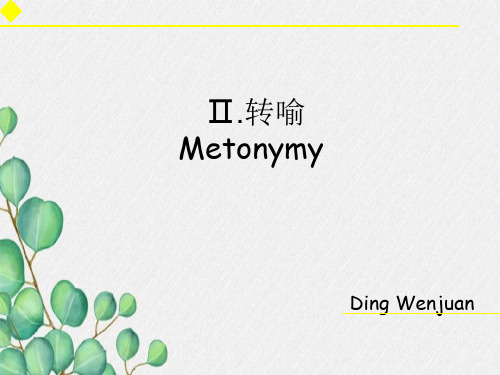
• 他提出从隐喻到转喻的连续体:多重对应 隐喻→单一对应隐喻→述谓用法的转喻→ 指称转喻。
• 在通感形容词例子中,判定不同感官域是否为独立的 域涉及认知域的层次性问题。在具体的层次上,他们 相互独立,映射发生在域间;但在总的感官体验的层 次上,不同的感官都是其次域,故映射发生在域内。
3. 关于其区分标准的再思考
• Haser(2005:30)的观点值得借鉴:借助母域或其它 类似概念作为区分隐喻和转喻的标准是存在问题的。
1.隐喻和转喻的基本关系和连续体
e.g. “UP”和“MORE”的概念可以说明“字面义-转喻-隐 喻连续体”的四个阶段:
UP 分离
MORE
UP︱MORE
隐喻 MORE IS UP 完全隐喻 UP FOR MORE
合并
UP+MORE
UP
部分隐喻 UP FOR UP+MORE 字面义
1.隐喻和转喻的基本关系和连续体
E.g. loud music/ loud color (吵人的音乐/花哨的颜色) Taylor(1995:139)认为该例子中听觉域的属性被映射到了视觉域,
这显然是隐喻。 Barcelona(2000a)作了更深入的分析,指出隐喻映射发生在具体的
听觉域“deviant sounds” 和具体的视觉域“deviant colors”之 间。色彩认知域有内在的标准,人们从不同的维度来识解色彩, 有时会看到一些打破标准的色彩。 “deviant sounds” 被理解为 “attention-getting deviant sounds”; “deviant colors”被理解 为“attention-getting deviant colors”。
隐喻转喻-专业文档!

隐喻转喻摘要:本文以隐喻和转喻作为研究重点,从横组合与纵聚合的区别切入,研究二者之间的同与不同。
并把这两组对照落实到文学文本的欣赏和作家的研究上。
隐喻;转喻;横组合;纵聚合;文学一.隐喻和转喻1.隐喻:隐喻是什么?历史上第一位对隐喻现象进行系统研究的学者亚里士多德认为:隐喻是通过把属于别的事物的词给予另一个事物而构成,或从“属”到“种”、或从“种”到“属”、或从“种”到“种”、或通过类比。
亚里士多德作为隐喻研究的先驱,认为人类语言中布满了隐喻,它是一种以非凡方式用在非凡场合的非凡语义偏离现象,起装饰或是调味品的作用。
隐喻的修辞学研究从古希腊一直持续到现在,学界至今对隐喻还没有一致定论。
修辞学家说,隐喻是辞格,是修饰话语的手段;逻辑学家认为,隐喻是范畴错位;哲学家说,人类语言从根本上是隐喻性的,;认知学家说,隐喻是人类认知事物的一种基本方式。
对隐喻定义的界定非常复杂,涉及到隐喻本质的方方面面,但也因此隐喻有了非凡的吸引力。
隐喻研究是当今语言学界的热点。
隐喻是我们熟悉世界和语言发生变化的重要手段。
一般来说有四个特点:新奇性、一致性、不对称性和具体性。
现代隐喻理论把隐喻被定义为不同高级经验领域里两个概念的映射(Lakoff&Turner1989)。
即将源域的特征映射到靶域,或者说靶域的概念可以通过源域来理解。
从源域到靶域的结构映射在三个不同概念层次上进行:本体映射,结构映射,逻辑知识映射。
(1)a.Weareatacrossroadsinourlife.b.You’reoffthetrackc.Thereisnowaybackd.Ourrelationshipisadead-endstreete.Wemayhavetogoourseparateways.f.Shegaveherlifeanewdirection.(转引自Feyaerts2000)本组的六个句子构成了“lifeisajourney”这样一个概念隐喻,旅行的过程与生活的不同方面相映射,将life变成一条road(从生命开始到结束,也就是从上路到旅程结束)。
认知语言学中的隐喻、转喻探究

认知语言学中的隐喻、转喻探究
隐喻和转喻是认知语言学中的两个重要概念,用于描述语言中的意义构建过程。
它们是通过将一个概念映射到另一个概念来实现的。
下面将分别对隐喻和转喻进行探究。
1. 隐喻(Metaphor)
隐喻是指通过将一个概念映射到另一个概念来构建意义。
在隐喻中,一个概念(称为隐喻源)用于理解另一个概念(称为隐喻目标),从而为目标概念赋予某种新的意义。
隐喻在语言中经常使用,有助于表达抽象的或难以言说的概念。
举个例子,我们经常使用“时间是金钱”这个隐喻来描述时间的重要性。
在这个隐喻中,时间被映射为金钱,表达出时间的珍贵和需要节省的意义。
通过隐喻的使用,我们能够更直观地理解时间的价值,并用金钱相关的概念来描述时间的使用和管理。
2. 转喻(Metonymy)
转喻是指通过将一个概念映射到与其相关的另一个概念来构建意义。
在转喻中,概念的转换是基于它们之间的关联性。
转喻可以通过将一个概念的某个方面或属性与另一个概念联系起来来实现。
举个例子,我们经常使用“白领”来代指从事脑力劳动的办公室职员。
在这个转喻中,白领这个词与白色衬衫相关联,而这种衣着风格又与办公室工作紧密相关。
因此,通过将衬衫作为办公室工作的代表,我们可以使用“白领”这个词来描述办公室职员。
隐喻和转喻在认知语言学中的研究中起着重要的作用。
它们不仅帮助我们理解语言的构建方式,还能揭示出人类对于概念的思维方式和观念转变的过程。
通过研究隐喻和转喻,我们能够更深入地理解语言和思维之间的关系,以及它们在实际交流中的应用。
隐喻转喻的对比分析
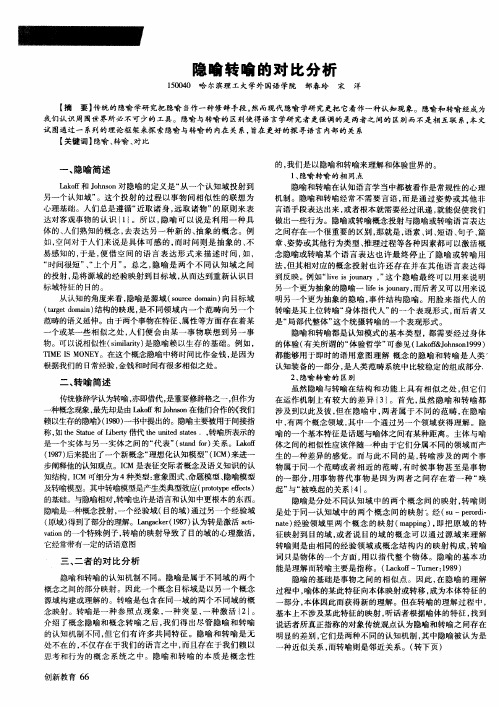
【 关键词 】 隐喻 、 、 比 转喻 对
的, 我们是 以隐喻和转喻来理解和体验世界的。
1 隐喻 转喻 的相 同 点 、
一
、
隐喻简 述
L kf和 Jh sn对 隐喻的定 义是“ ao o no 从一个认 知域投射到 另一个认知域” 。这个投射 的过程 以事 物问相 似性 的联 想为 心理基础。人们总是遵循 “ 近取诸 身 , 远取 诸物 ” 的原则 来表 达对客观事物的认识 { } 1 。所 以, 隐喻可 以说是 利 用一 种具 体 的、 人们熟知 的概念 , 去表达 另一 种新 的、 象 的概 念。例 抽 如, 空间对 于人们来说是 具体可感 的 , 而时 间则是抽 象 的、 不 易感知 的, 于是 , 借空 间 的语言 表达 形式 来 描述 时 间 , , 便 如 “ 时间很短 ” “ 、上个月” 。总之 , 隐喻 是两个 不 同认 知域 之间 的投射 , 是将源域的经验映射到 目标域 , 而达 到重新认 识 目 从 标 域 特 征 的 目的 。
隐喻 转 喻 的对 比分 析
104 哈 尔滨理工大 学外 国语 学院 500 邹春玲 宋 洋
【 摘
要 】 统的隐喻 学研 究把 隐喻 当作一种修辞手段 , 传 然而现代 隐喻 学研 究更把 它看作一种认 知现 象。隐喻和转喻经成为
我们认识周 围世界所必不可少的工具 。隐喻与转喻 的区别使得语 言学研 究者更强调 的是 两者之 间的区别而不是 相互联 系, 本文 试 图通过一 系列的理论框架来探 索隐喻 与转喻 的 内在 关系, 旨在更好的探寻语言 内部的关 系
范畴的语义延伸。由于两个事物在特征 、 属性等方 面存在着某 个或某一些相 似之处 , 人们便会 由某一 事物联 想 到另一事
隐喻与转喻认知对比研究

隐喻与转喻的认知对照研究纲要:认知语言学以为隐喻和转喻不但是两种修辞方式,并且是重要的人类思想方式,是人类认识客观世界的认知方式,对人类认识事物、事物看法构造的形成以及语言的发展都起侧重要的作用。
二者既有共性,也存在差异。
本文将联合网络流行语中的详细语例对隐喻和转喻进行对照剖析,研究结果有助于加深学习者对隐喻和转喻的理解。
重点词:隐喻;转喻;认知;网络流行语Richards 说,“隐喻是人类语言无处不在的原动力”,我们的平时生活中充满了隐喻与转喻。
传统的语言学将隐喻和转喻看作是语言形式上的修辞,是语言装修的手段。
而认知语言学以为隐喻和转喻不但是语言中的修饰手段,仍是人类认识客观世界强有力的工具。
一.认知语言学中的隐喻和转喻1.1 隐喻与转喻的认知剖析隐喻被以为是“人们思想、行为和表达思想的一种系统的方式”,往常包含本体和喻体,经过把两种拥有同样特点的事物进行对照,表示本体和喻体之间的相像关系。
隐喻的本质就是“经过其余事物来理解和体验某一事物”,是从一个认知域(源域)投射到另一个认知域(目的域)。
换言之,隐喻是以源域的经验来理解目的域的经验,前者往常是人们较为熟习的详细的看法域,后者则是人们不太熟习的抽象的看法域。
源域的特点被映照到目的域上,后者因前者而获得理解。
“转喻”在传统修辞学中被称为“借代”。
与传统看法不一样,认知语言学以为,转喻不但是一种语言现象,也是一个认知过程,它是指“相靠近或有关系的不一样认知语域中,一个突显事物代替另一事物,如部分与整体、容器与其功能或内容之间的代替关系” 。
如果说隐喻是两个不一样认知域之间的映照,那么转喻则是在同一认知域内的矩阵域与次域之间的映照。
必定的认知框架内以明显的东西转喻借指不明显的东西是人类认知的一般规律,转喻的运作体制在很大程度上就是依靠于认知域内的成分突显。
1.2 隐喻与转喻的关系认知语言学以为隐喻和转喻及其余语言修饰手段,皆源于人们表达过程中的需要,为了辨别新的信息和事物,大脑会借用已知的事物和已有的语言形式来认知新的事物。
英汉语言中“眼”的隐喻与转喻意义的对比考察

英汉语言中“眼”的隐喻与转喻意义的对比考察隐喻和转喻是人类重要的认知模式,对身体词的各种活用又是隐喻和转喻的突出体现。
本文从隐喻和转喻的概念入手,从隐喻和转喻的定义出发,通过比较两者的区别,分析英语和汉语这两种语料,以此来探索“眼”的隐喻和转喻意义标签:眼转喻隐喻英汉对比一、引言认知语言学认为,概念隐喻和转喻意义系统是基于感知体验,而感知体验又是基于人的身体构造。
由此可见,人的身体及其感觉在隐喻意义形成和概念化的过程中起到了至关重要的作用。
“眼”作为视觉器官,是人身体感觉中最为重要的一部分,可以有各种不同的隐喻和转喻意义。
本文试从认知语言学的角度出发,结合隐喻和转喻的定义及两者的比较,系统探讨英汉这两种语言中“眼”的隐喻和转喻意义。
具体考察其个性和个性及其背后的构词理据。
本文采用的语料主要有两种:北京大学汉语语言学研究中心的现代汉语语料库;British National Corpus。
George Lakoff认为,隐喻的认知基础是“意象图式”,意象图式来源于我们的日常生活。
与隐喻相同,转喻也是基于人们的基本经验,其实质是概念性的,是自发的、无意识的认知过程,是丰富语言的重要手段。
然而,人类的身体是认知的主体,身体与外部世界的互动过程中所获得的体验是人类认识客观世界的基础。
维柯指出:“在一切语言里,大部分涉及无生命事物的表现形式,都是从人体以及人的感觉和情欲那里借来的隐喻。
”同样,通过对身体词的转喻,语言得到了极大的丰富。
例如,杯子可以有“口”,凳子可以有“脚”,茶壶可以有“嘴”,“国脚”代替著名足球运动员。
“眼睛”作为心灵的窗户,在人体部位中占据着重要的地位,有着至关重要的作用。
在汉语和英语中发现有很多“眼”的隐喻和转喻表达式。
下面就从隐喻和转喻的定义出发,通过比较两者的区别,分析英语和汉语这两种语料,以此来探索“眼”的隐喻和转喻意义。
二、隐喻与转喻的比较隐喻是从始源域到目标域的概念化映射。
隐喻与转喻的对比研究——王朝阳
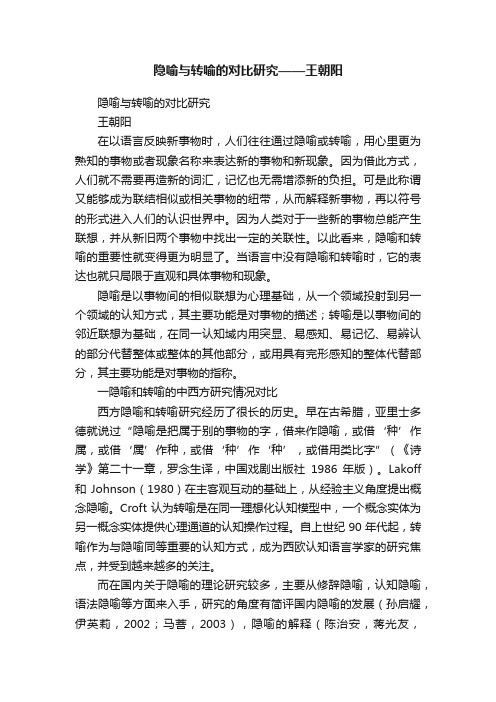
隐喻与转喻的对比研究——王朝阳隐喻与转喻的对比研究王朝阳在以语言反映新事物时,人们往往通过隐喻或转喻,用心里更为熟知的事物或者现象名称来表达新的事物和新现象。
因为借此方式,人们就不需要再造新的词汇,记忆也无需增添新的负担。
可是此称谓又能够成为联结相似或相关事物的纽带,从而解释新事物,再以符号的形式进入人们的认识世界中。
因为人类对于一些新的事物总能产生联想,并从新旧两个事物中找出一定的关联性。
以此看来,隐喻和转喻的重要性就变得更为明显了。
当语言中没有隐喻和转喻时,它的表达也就只局限于直观和具体事物和现象。
隐喻是以事物间的相似联想为心理基础,从一个领域投射到另一个领域的认知方式,其主要功能是对事物的描述;转喻是以事物间的邻近联想为基础,在同一认知域内用突显、易感知、易记忆、易辨认的部分代替整体或整体的其他部分,或用具有完形感知的整体代替部分,其主要功能是对事物的指称。
一隐喻和转喻的中西方研究情况对比西方隐喻和转喻研究经历了很长的历史。
早在古希腊,亚里士多德就说过“隐喻是把属于别的事物的字,借来作隐喻,或借‘种’作属,或借‘属’作种,或借‘种’作‘种’,或借用类比字”(《诗学》第二十一章,罗念生译,中国戏剧出版社1986 年版)。
Lakoff 和Johnson(1980)在主客观互动的基础上,从经验主义角度提出概念隐喻。
Croft认为转喻是在同一理想化认知模型中,一个概念实体为另一概念实体提供心理通道的认知操作过程。
自上世纪90年代起,转喻作为与隐喻同等重要的认知方式,成为西欧认知语言学家的研究焦点,并受到越来越多的关注。
而在国内关于隐喻的理论研究较多,主要从修辞隐喻,认知隐喻,语法隐喻等方面来入手,研究的角度有简评国内隐喻的发展(孙启耀,伊英莉,2002;马菩,2003),隐喻的解释(陈治安,蒋光友,1999;李海辉,2000;朱文清,2001)等。
转喻研究有:词义、概念的转隐喻研究(林正军,杨忠,2005;廖光蓉,2005;张建理,2005;杨海明,2005)。
隐喻和转喻的区别课件

隐喻映射的基础是相似性
隐喻是通过相似性将一个概念映射到另一个概念上,两个概念之间存在某种内在的相似性。
转喻映射的基础是相关性
转喻则是通过相关性将一个概念映射到另一个概念上,两个概念之间存在直接的关联或相互依存的关系。
隐喻是通过暗示或间接的方式将一个概念映射到另一个概念上,不直接指明两者之间的关系。
01
02
转喻常常用于日常口语、新闻报道等领域,通过指代、借代等方式,使语言更加简洁明了,提高语言的使用效率。
转喻是一种修辞手法,通过一个事物的部分或特征来代表整个事物或概念,以简化语言表述过程。
隐喻和转喻的相似之处
隐喻和转喻都是通过语言来表达思想的方式,它们都是修辞手法的一种。
它们都能够帮助人们更好地理解和表达自己的想法,使语言更加生动、形象和有力。
隐喻是间接映射
转喻则是直接用一个概念来指代另一个概念,两者之间的关系明确且直接。
转喻是直接映射
在隐喻中,相似性是关注的焦点,通过相似性来表达和传达意义。
在转喻中,相关性是关注的焦点,通过相关性来指代和说明另一个概念。
转喻的焦点是相关性
隐喻的焦点是相似性
隐喻和转喻的应用场景
隐喻是文学创作中常用的修辞手法,通过比喻的方式使语言更加生动形象,增强作品的艺术感染力。
详细描述
VS
通过相关性建立比喻关系
详细描述
转喻是通过相关性将一个事物与另一个事物相比较,从而建立比喻关系。例如,“他是个书呆子”,这个比喻中,“书呆子”和“他”之间的相关性是“他”经常读书,这种比喻方式能够简洁明了地表达出说话者对“他”的看法。
总结词
总结与思考
在文学作品中,隐喻和转喻都是常用的修辞手法。通过运用这些手法,作家可以更好地表达人物情感、刻画人物形象、描绘场景等,使作品更具艺术感染力。
隐喻和转喻的区别
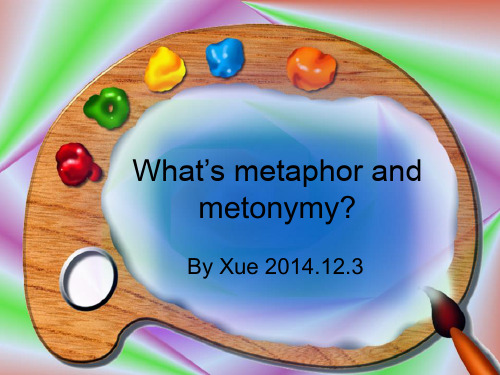
By Xue 2014.12.3
Metaphor: a word or phrase used to describe sb/sth else, in a way that is different from its normal use, in order to show that the two things have the same qualities and to make the description more powerful, for example she has a heart of stone隐喻
隐喻发生地点:
转喻发生地点:
两个相关的认知域内
(始源域和目标域)。
同一认知域的映射,
“可以是整个认知域代替 某一子域,反之亦然”。 Barcelona,2002 转喻是基于 事物之间的邻近性特征,以此 代彼的思维过程。 邻近性可以是 1.空间上, 2.时间上, 3.因果上。
映射是基于 相似性的跨空间对接。 相似性可以是 1.形式上的相似性, 2.感知得到的相似性, 3.依据经验存在的相关性。
•Kovesces, 2002
•相同点:转喻同隐喻一样,是人类的一种基本思维方式和认知手段。 •不同点:不同于隐喻,转喻是基于事物之间的邻近性特征,以此代彼 的思维过程。 ——蔡晖,2006
转喻
• • • • • • 整体与部分关系 1事件模型 2构造模型 3复杂事件模型 4范畴成员模型 5范畴属性模型
the use of such words and phrases Metonymy (technical) the act of referring to sth by the name of sth else that is closely connected with it ,for example using the White House for the US president转喻。 转喻:在同一理想化认知模型中,有一个 概念实体为另一个概念实体提供心理通道 的认知过程。Kovescses,2002
转喻与隐喻的概念及其两者的关系-心理语言学论文-语言学论文

转喻与隐喻的概念及其两者的关系-心理语言学论文-语言学论文——文章均为WORD文档,下载后可直接编辑使用亦可打印——一、隐喻和转喻的概念从人类社会的语言实践来看,在日常的交际语言及诗词歌赋中都会运用隐喻或转喻来表达感情。
从认知语言学来看,它不仅是人类表达语言的主要表现,也是最为基本的认知方式和思维方式,更是扩展词义的实现要素。
通常来讲,隐喻以及转喻都被视为修辞学中的两种手段,之前的主流语言学家将隐喻与转喻划入到语言异体形式。
但是,从认知语言学来看,隐喻以及转喻表达属于人类语言表达现象,也应将其纳入在语言研究中。
它们不仅是语言现象,还是两种最基本的语言认知方式。
语言学在解释语言时运用了与众不同的理论,认为隐喻和转喻是对抽象范畴进行概念化的有效途径,并且在日常生活的语言沟通以及交流中发挥着至关重要的作用。
隐喻将相似性当成了自身的认知基础,从而为人类认识宇宙万物以及自身之间搭建关联域。
而且出现了两个有密切关联的概念域,其中之一为始源域,也可以被称作始发模型,其二为目标域,也可以被叫做目的模型.目标域或始源域在形成关联是相互而存在的,而且分别形成了各种的概念网络体系,包括了人类在认知该事物之前的经验以及概念。
从隐喻来看,目标域以及始源域在相似性的基础上形成了关联,它的决定性因素是人脑中的认知语境。
人类系统化的认知结构形成了认知语境,它涵盖了语言上下文、直接场合、社会心理表征以及知识等。
与目标域(本体)相对比而言,说话者或听话者要要更为熟悉隐喻的始源域(喻体)。
但是,在二者形成关联以及发生互动反应的过程中,就很容易激活与日常观念相关的联想系统。
在此基础上,可以将人们通常比较熟悉的事物映射到人们不太熟悉的事物上(在结构与内容方面)。
这样一来,隐喻就可以为人们深入把握目标域的特点以及结构提供较大帮助,人类的认知功能也因此而形成。
隐喻在此过程中具有创造性、能动性特征的过程,它表现为人们利用所熟悉的事物,从而不断认识、把握未知事物,深入理解已知事物的活动。
隐喻和转喻的区别PPT课件
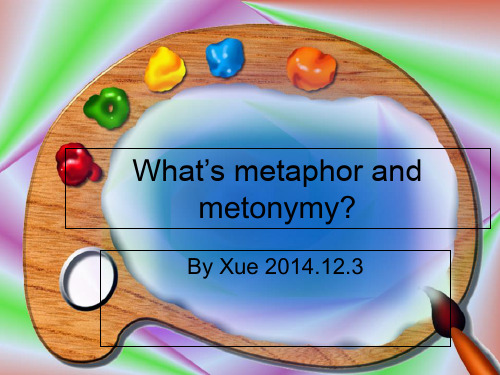
By Xue 2014.12.3
1
Metaphor: a word or phrase used to describe sb/sth else, in a way that is different from its normal use, in order to show that the two things have the same qualities and to make the description more powerful, for example she has a heart of stone隐喻
You Know, The More Powerful You Will Be
结束语
感谢聆听
不足之处请大家批评指导
Please Criticize And Guide The Shortcomings
讲师:XXXXXX XX年XX月XX日
转喻:在同一理想化认知模型中,有一个
概念实体为另一个概念实体提供心理通道
的认知过程。Kovescses,2002
2
如果说认知语言学是研究语言特征如何反映 人类的认知方式,那么隐喻就是对两者关系
最明确的诠释 ——Grady,1997
• 隐喻与概念隐喻 • 隐喻普遍存在我们的日
常生活中,语言中有隐 喻,思维和行为中也存 在隐喻。 • 我们在言语交际活动中 使用的是相同的概念系 统,因而也是隐喻性的。 • 这些统称为概念隐喻。
邻近性可以是
1.空间上, •Kovesces, 2.时间上, 2002
3.因果上。
•相同点:转喻同隐喻一样,是人类的一种基本思维方式和认知手段。
隐喻和转喻中认知突显的对比分析

隐喻和转喻中认知突显的对比分析一、引言传统修辞学把隐喻和转喻看作一种修辞现象,没有清楚地界定隐喻和转喻的概念范围。
Lakoff和Johnson认为隐喻和转喻是两种不同的认知过程,隐喻是通过一类事物来理解和经历另一类事物,其主要功能是理解;转喻主要实现其所指功能,即用一个概念实体来替代另一个概念实体。
国内外一些学者(如蔡晖;束定芳;刘正光;John A.Barnden等)从隐喻和转喻的理据来源、结构和功能、运作机制、区分标准等方面对二者进行了对比分析。
本文从认知突显角度出发,基于隐喻和转喻产生的认知理据,对隐喻和转喻思维形成中的认知突显的异同进行了对比分析。
二、隐喻与转喻的认知理据赵艳芳认为,隐喻的形成是基于两事物间的合成相似。
在隐喻结构中,将两种通常看来毫无联系的事物相提并论,是因为在认知领域人类对其产生了相似联想。
即隐喻是以事物间的相似性联想为心理基础、从一个认知域投射到另一个认知域的认知方式。
例如:(1)运动员像离弦的箭一般向终点跑去。
在例(1)中,施喻者将“运动员”喻为“离弦的箭”。
前者属于人的范畴,后者属于工具的范畴。
“离弦的箭”具有速度极快的特点,在赛场上奔跑的运动员其速度也非常之快,施喻者将这两个不同事物的特点进行了相似性联想,将事物的特点从一个认知域投射到了另一个认知域,从而构建了这个隐喻。
然而,事物之间的差异性是绝对的,相似性是相对的,这种相似性关系并非纯粹是客观事物存在的共同点,而是通过认知主体对事物的主观感知加上对事物本身的客观特征或特性的融合而构成的合成相似。
与隐喻不同,转喻是用突显、易感知、易记忆、易辨认的部分代替整体或其他部分,或用具有完型感知的整体代替部分的认知过程。
因此,转喻的两个主要特征是邻近性和突显性。
隐喻是不同认知域之间的投射,转喻是相接近或相关联的不同认知域中,一个突显事物替代另一个事物,如部分与整体、容器与其功能或内容之间的替代关系。
也就是说在转喻中转体和转喻目标是一种替代的关系,转体代表了本体的某一典型特征。
隐喻和转喻的区别课件

目
CONTENCT
录
• 隐喻和转喻的定义 • 隐喻和转喻的相似之处 • 隐喻和转喻的区别 • 隐喻和转喻的实例分析 • 隐喻和转喻的应用场景 • 如何区分隐喻和转喻
01
隐喻和转喻的定义
隐喻的定义
隐喻是一种修辞方式,通过将一个概念或事物与另一个概念或事 物相比较,来表达更深层次的意义或情感。
两者都可以增强语言的表现力
隐喻和转喻都能够使语言更加生动、形象和有力,增强语 言的表现力。
两者都能够引发人们的联想和想象,使人们更好地理解和 感受语言的魅力。
03
隐喻和转喻的区别
隐喻是基于相似性,转喻是基于邻近性
隐喻
通过将一个概念与另一个概念相比较,基于它们之间的相似性来 表达意义。例如,“时间就是金钱”,这里将时间与金钱进行比 较,强调时间的宝贵。
语言特点
转喻使用指代词“一支”来代替“抽烟”这个动作或行为,使语言更加 简洁明了。
03
认知效果
转喻可以帮助人们快速理解语言中的指代关系,减少语言中的冗余信息
,使语言表达更加经济和高效。
05
隐喻和转喻的应用场景
隐喻在文学、广告和日常交流中的应用
80%
文学创作
隐喻是文学中常用的修辞手法, 通过比喻的方式将抽象的概念具 体化,增强语言的表现力和感染 力。
100%
广告宣传
广告中经常使用隐喻来描述产品 或服务的特性和优点,使消费者 更容易理解和接受。
80%
日常交流
在日常交流中,人们也会使用隐 喻来表达自己的想法和感受,使 语言更加生动形象。
转喻在新闻、演讲和商业广告中的应用
新闻报道
在新闻报道中,转喻常被用来 指代某个事物或事件,以简化 语言和提高报道效率。
- 1、下载文档前请自行甄别文档内容的完整性,平台不提供额外的编辑、内容补充、找答案等附加服务。
- 2、"仅部分预览"的文档,不可在线预览部分如存在完整性等问题,可反馈申请退款(可完整预览的文档不适用该条件!)。
- 3、如文档侵犯您的权益,请联系客服反馈,我们会尽快为您处理(人工客服工作时间:9:00-18:30)。
Cognitive LinguisticsKey Points1. Basic concepts cognitive linguistics cateory categorization prototype prototype theoryMetaphor metonymy iconicity grammaticalization2. The classical theory of categorization3. The prototype theory of categorization4. Conceptual metaphor and metonymy5. Major types of iconicity in language6. Grammaticalization10.2 Categorization and categoriesHave you seen a tree? I bet that strictly speaking you haven’t, for you have seen a willow, a p each tree, or any particular tree, but you haven’t seen an abstract tree. The same is true with the word dog. Have you seen a dog? You haven’t, not in the abstract sense of the word. You have seen a white dog, a yellow dog, your own dog or your neighbour’s dog, but you haven’t seen an abstract dog. A dog (or a tree for that matter) stands for all the characteristics of the species it refers to. The special term for this phenomenon is called category. And the mental process of classification is called categorization, which is one of the important capabilities of the human mind.Categorization occurs everywhere around us, without it a lot of information would be in disorder. In fact, people are quite able to divide the world into categories, and they can learn to distinguish between different categories such as CAR and BUS. For example, as a student, you may be classified as a FRESHMAN, SOPHOMORE, JUNIOR, or SENIOR; you may also be classified by your major. As to the colour system, we have colour categories, such as RED, WHITE, BLACK, YELLOW, and BLUE. Movies in America have already been categorized as G (General Audiences: used to mean that a film is suitable for anyone to watch), PG (parental guidance: used to describe a film containing scenes, subjects, or language considered unsuitable for children unless they have a parent with them), R (restricted: used to mean that the people under the age of 17 cannot go to a particular film unless they go with an adult), or X (used to mean that a film is not suitable for people under the age of 18). The list of categorization examples is practically endless.But what principles do people use when they do categorizing. Generally speaking, there are two major theories which deal with this problem. One is the classical theory, and the other is the prototype theory.10.2.1 The classical theoryThe classical theory of categorization can be traced back to Aristotle, and it is carried forward by structuralist and transformationalist linguists.According to this theory, in the BIRD category, for example, if a creature has two wings, two legs, a beak, feathers and lays eggs (these are the necessary conditions), then it is a bird; on the other hand, if a creature has all these features, this is also sufficient for classifying it as a bird. This seems to tell us that categories are defined by a limited set of necessary and sufficient conditions (these conditions are regarded as features). In other words, a thing cannot both be and not be, it cannot both have a feature and not have it, it cannot both belong to a category and not belong to it. This is the first assumption of the classical theory.In the definition of a category, one of two values, either [+] or [–], can be used. For example, the BIRD category has the feature [+two legs], but [–four legs]. This means that a feature is either in the definition of a category, or it is not; an entity either has this feature, or it does not. That is, features are binary. This is the second assumption.Once a category has been established, it has divided the universe into two sets of entities. In this case, some entities are the members of the category, while the others are not. There are no borderline cases. For instance, after the BIRD category is formed, some creatures such as the sparrow, the robin, and the swallow are the members of BIRD, but others such as lions, tigers, and bears are not, because the latter are the members of the BEAST category. The view can be demonstrated in the following figure:This shows that the two categories BIRD and BEAST have clear boundaries. In general, categories have clear boundaries. This is the third assumption.The fourth assumption is that all members of a category have equal status. This means that a member that has all the features of a category is a full member of the category; a member that does not have all the features is not a member. There is no such case in which one member is better than others in the same category. Therefore, according to this view, we cannot say that the sparrow is a better member than the ostrich in the BIRD category.The classical theory has dominated for a long time, but it has also suffered from criticisms. Such a view of categorization is bound to run into difficulties when it is used to describe categories which have good and bad members and fuzzy boundaries. Things in the world are much too complex for a theory as neat as the classical theory. Certain things do not fall into clear-cut categories. For instance, do ostriches and penguins belong to the BIRD catego ry? Even if they do, aren’t they less of birds than robins are? Then what about ducks and peacocks? Are they more of birds than penguins? (See Figure 1 in the next section)10.2.2 Prototype theoryIn the fruit category there are a great number of examples such as orange, apple, banana, peach, apricot, plum, tangelo, and papaya. If you are asked which are the best examples, you would possibly answer that orange and apple are the best ones. The best examples of a category are called prototypes.Some scholars think that natural categories are organized according to prototypes. According to prototype theory, people decide whether an entity belongs to a category by comparing that entity with a prototype. If the entity is similar to the prototype, it is included in the category. However, if it is sufficiently different, it is placed in another category, in which it resembles the prototype for that category more closely. Members of a category therefore differ in their prototypicality, or degree to which they are prototypical. For example, a robin and a sparrow are very prototypical birds, while ostriches and penguins are very low in prototypicality. In fact, ostriches and penguins can be called nonprototypes because they are far away the prototype of a birdFigure 1: The BIRD categoryPrototype theory started in the mid-1970s with E. Rosch’s psycholinguistic research into the internal structure of categories. From its psycholinguistic origin, prototype theory has moved mainly in two directions. On the one hand, information-processing psychology takes Rosch’s findings and proposals, and tries to devise formal models for human conceptual memory and its operation. On the other hand, prototype theory has a steadily growing success in linguistics since the early 1980s. It is this linguistic tradition of prototype-theoretical research that prototype theory has a very important status in cognitive linguistics.Prototype theory is useful for explaining how people deal with untypical examples of a category. This is how unbirdy birds such as penguins and pelicans can still be regarded as birds. They are sufficiently like the prototype, even though they do not share all its characteristics. But it has a further advantage: it can explain how people deal with damaged examples. Previously linguists had found it difficult to explain why people could still categorize a one-winged robin who couldn’t fly as a bird, or a three-legged lion as a lion. Now we just assume that these get matched against the prototype in the same way as an untypical category member. A one-winged robin who can’t fly can still be a bird, even though it’s not such a typical one. In addition, prototype theory can work for actions as well as objects. For example, people can judge that murder is a better example of killing than execute or suicide, and that stare is a better example of looking than peer or squint.10.2.3Levels of categorizationAn object can belong to many different, related categories. For example, the wooden object upon which you are sitting can be called by several different names: furniture, chair, or desk chair. So we can see that categories arrange from level to level. Some category levels are called superordinate levels, which mean higher levels or more general levels. Furniture and animal areexamples of superordinate category levels. Basic-level categories are more specific, but not too specific. Chair is an example of basic-level categories. Finally, there are subordinate levels, which means lower level or more specific categories. Desk chair is an example of subordinate categories. However, basic level categories have a special status. Notice that there are differences between the terms prototype and basic-level category. A prototype is a best example of a category, whether the category level is superordinate, basic-level, or subordinate. It has been found that children learn basic level words first, for the simple reason that they are not too general nor too specific and they are most useful. Basic level categories are basic in three respects.(a)Perception: Overall perceived shape; single mental image; fast identification.(b)Communication: Shortest, most commonly used and contextually neutral words, first learned by children and firstto enter the lexicon.(c)Knowledge organization: Most attributes of category members are stored at this level.It is not hard to see that basic level categories take primacy over categories at other levels. This is mostly because it is at this level that we perceive the evident differences between objects and organisms of the world. Most of the time, we understand superordinate categories in aid of the features of basic level categories. For instance, the comprehension of furniture comes from the collective properties of typical members like chairs, tables, desks, and beds in the basic level. Similarly, by the time a child can understand animal, he must have learnt cat, dog, lion, tiger, cow, and many others.10.3Conceptual metaphor and metonymy10.3.1Conceptual metaphorTraditionally, metaphor is a figure of speech in which one thing is compared to another by saying that one is the other, as in “He is a tiger”. It is a property of words, and is used for some artistic and rhetoric purpose. However, this view has been challenged recently by cognitive linguists. In the cognitive linguistic view, metaphor is a property of concepts, and it is a powerful cognitive tool for our conceptualization of abstract categories. It is pervasive in our language.According to cognitive linguistics, metaphor is defined as understanding one conceptual domain or cognitive domain in terms of another conceptual domain. The conceptual domain from which we draw metaphorical expressions to understand another conceptual domain is called source domain(“tiger” in the above example), while the conceptual domain that is understood this way is called target domain(“He” in the above example). Thus, metaphor can be diagrammed as follows:Thus, in cognitive linguistics metaphor is called conceptual metaphor because it is a property of concepts. From this diagram we can see that a conceptual metaphor consists of two conceptual domains, in which one domain is understood in terms of another. Some examples of conceptual metaphor are in the following:(5) LOVE IS A JOURNEYLook how far we’ve come.We’ll just have to go our separate ways.We can’t turn back now.Our marriage is on the rocks.We’ve gotten off the track.This relationship is foundering.(6)IDEAS ARE FOODThere are too many facts here for me to digest them all.I just can’t swallow that claim.That’s food for thought.He devoured the book.(7)AN ARGUMENT IS WARYour claims are indefensible.They attacked every weak point in our argument.I’ve never won an argument with him.You disagree? Okay, shoot!If you use that strategy, he’ll wipe you out.He shot down all of my arguments.10.3.2Conceptual metonymyAccording to the classical definition, metonymy is a figure of speech in which one word is substituted for another on the basis of some material, causal, or conceptual relation. Some typical substitutions include author for work, place for a characteristic product of that place, object for possessor, abstract features for concrete entities, etc. Some examples are:(8)Have you ever read Shakespeare?(9)Wary wants Burgundy (red or white wine from the Burgundy area of France).(10)T he crown objects to the proposal.(11)I want my love to be with me all the time.However, the rhetorical treatment of metonymy faces an interesting paradox. On the one hand, it captures a lot of phenomena which continue to be productive and wide-spread in a variety of languages; in addition, these seem to be produced and understood naturally and spontaneously. On the other hand, it regards metonymy as a figure of speech, that is, a departure from the linguistic norm, serving ornamental and literary purposes and demanding suitable training for its successful use and comprehension.When we turned to a cognitive view of figurative language, we only paid attention to the role of metaphor but not that of metonymy, in the construction of abstract categories. However, metonymy does play a very important part in the structures of emotion categories. For example, we have a general metonymic principle: THE BODIL Y SYMPTOMS OF AN EMOTION STAND FOR THE EMOTION. According to this principle, we can find that there are indeed bodily symptoms which seem to be helpful for a description of the conceptual structure of emotions because they are peculiar to one particular emotion: drop in temperature for FEAR (e.g. “I was chilled to the bone.”), erect posture for PRIDE (e.g. “He swelled with pride.”), drooping posture for SADNESS (e.g. “My heart sank.”), and jumping up and down for JOY (e.g. “He was jumping for joy.”). Obviously these physiological phenomena help us in conceptualizing these emotions.Metonymy differs from metaphor in a cognitive theory, but they also work together. As a matter of fact, the main claims made by cognitive linguists in the description of metaphor also apply to metonymy: (i) both are regarded as being conceptual in nature; (ii) both can be conventionalized (i.e. automatic, unconscious, effortless and generally established as a model of thinking); (iii) both are means of extending the resources of a language; and (iv) both can be explained as mapping processes. The main difference between them is that metaphor involves a mapping across different conceptual or cognitive domains while metonymy is a mapping within one conceptual domain. In metonymy, one category within a domain is taken as standing for another category in the same domain. The main function of a metonymic expression is to activate one cognitive category by referring to another category within the same domain (see examples (8)-(11)), and by doing that, to highlight the first category or the subdomain to which it belongs. Consider the following three examples of part-whole relations (Croft, 1993: 350):(12)W e need a couple of strong bodies for our team.(13)T here are a lot of good heads in the university.(14)W e need some new faces around here.Obviously, in the three sentences above a reference to human beings is being made. What is interesting here about them is that in each case one particular relevant aspect of a human being is highlighted. In the sports context of the first example, the domain PHYSICAL STRENGTH related to the category BODY is highlighted, and in the university context the domainINTELLIGENCE is related to HEAD. The category FACE is particularly appropriate in the context of new people, because this is what we usually perceive first when we meet strangers.So, given the observations above, we can offer the cognitive linguistic definition of metonymy: Metonymy is a cognitive process in which one cognitive category, the source, provides mental access to another cognitive category, the target, within the same cognitive domain, or idealized cognitive model (ICM).This understanding of metonymy can be represented as the following figure:Generally speaking, the most commonly used conceptual metonymies are as follows:(15)T HE PRODUCER FOR THE PRODUCT (THE AUTHER FOR THE WORK)She loves Picasso.Does he have any Hemingway in his collection?I’m reading Mark Twain.(16)T HE PLACE FOR THE EVENTAmerica doesn’t want another Pearl Harbor.Watergate changed American politics.(17)T HE PLACE FOR THE INSTITUTIONWashington is negotiating with Beijing.Wall Street is in a panic.Hollywood is putting out terrible movies.(18)T HE CONTROLLER FOR THE CONTROLLEDNixon bombed Hanoi.Ozawa gave a terrible concert last night.(19)A N OBJECT USED FOR THE USERThe sax has the flu today.We need a better glove at the third base.Thus, we can say that one kind of entity, such as the one referred to by the word Hemingway, the AUTHER or PRODUCER, “stands for” another kind of entity, such as the one referred to by the expression one of Hemingway’s work s, the WORK or PRODUCT. In the same way, we get the PLACE for the EVENT, the PLACE for the INSTITUTION, the CONTROLLER for the CONTROLLED, etc. Metonymies, then, similar to metaphors, are conceptual in nature, and the conceptual metonymies are revealed by metonymic linguistic expressions. There are many other conceptual metonymies besides the ones above; for example, we have PART FOR WHOLE (as in, “We need some good heads on the project”); WHOLE FOR THE PART (as in, “America is a powerful country”); INSTRUMENT FOR ACTION (as in, “She shampooed her hair); EFFECT FOR CAUSE (as in, “It’s a slow road”); DESTINATION FOR MOTION (as in, “He porched the newspaper”.。
